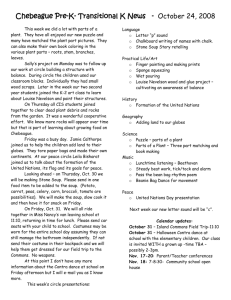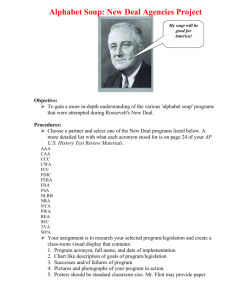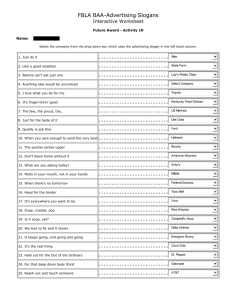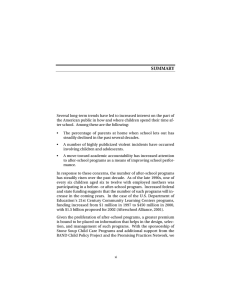ADHERENCE TO AFTER-SCHOOL CARE PRACTICES BY STONE SOUP PROGRAMS: RESULTS
advertisement
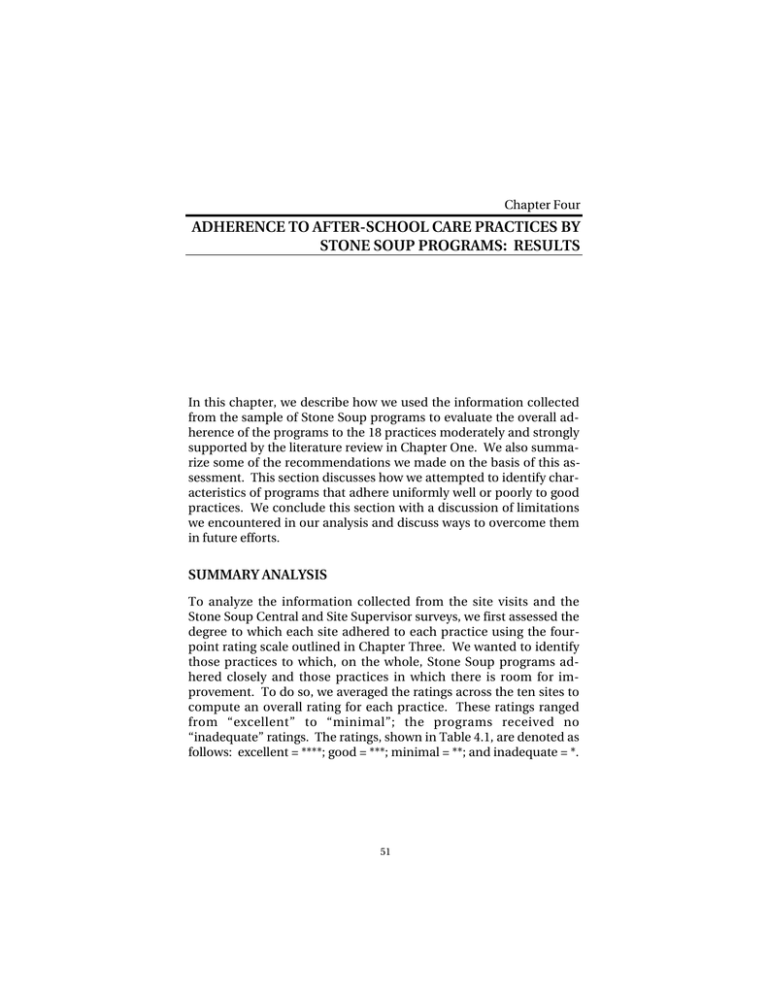
Chapter Four ADHERENCE TO AFTER-SCHOOL CARE PRACTICES BY STONE SOUP PROGRAMS: RESULTS In this chapter, we describe how we used the information collected from the sample of Stone Soup programs to evaluate the overall adherence of the programs to the 18 practices moderately and strongly supported by the literature review in Chapter One. We also summarize some of the recommendations we made on the basis of this assessment. This section discusses how we attempted to identify characteristics of programs that adhere uniformly well or poorly to good practices. We conclude this section with a discussion of limitations we encountered in our analysis and discuss ways to overcome them in future efforts. SUMMARY ANALYSIS To analyze the information collected from the site visits and the Stone Soup Central and Site Supervisor surveys, we first assessed the degree to which each site adhered to each practice using the fourpoint rating scale outlined in Chapter Three. We wanted to identify those practices to which, on the whole, Stone Soup programs adhered closely and those practices in which there is room for improvement. To do so, we averaged the ratings across the ten sites to compute an overall rating for each practice. These ratings ranged from “excellent” to “minimal”; the programs received no “inadequate” ratings. The ratings, shown in Table 4.1, are denoted as follows: excellent = ****; good = ***; minimal = **; and inadequate = *. 51 52 Accountability for After-School Care Table 4.1 Summary Ratings by Practice Practice Staff characteristics Training staff Education Compensation Program characteristics Variety of activities Flexibility of programming Emotional climate Child-to-staff ratio Total enrollment Mixing of age groups Age-appropriate activities Space and furnishings Continuity and complementarity with day school programs Clear goals and evaluation of program Materials Attention to safety and health Community contacts Involvement of families Use of volunteers Partnerships with communitybased organizations, etc. Summary Rating **** ** *** *** *** *** *** *** *** ** *** ** *** *** *** *** ** *** Next, we broke the “good” category, which comprised most of the practices, into two parts: that for which there was little variation in ratings across sites, and that for which there was greater variation. The first part includes those practices whose adherence scores did not vary by more than one category. We were interested in finding practices to which adherence varied substantially across sites, because this variation suggested room for improvement on the part of some sites (if some sites adhered at the excellent or good level, perhaps all could). The next subsection presents the Stone Soup results we presented for three practices. The intent of this discussion is to illustrate how to conceptualize adherence to practices across a group of programs and Adherence to After-School Care Practices by Stone Soup Programs: Results 53 to illustrate the types of recommendations that can be made on the basis of this type of analysis. For the first practice, training staff, Stone Soup received an “excellent” rating. The second practice represents one in which Stone Soup did well with little variation. The third practice is one for which they received a “good” score, but with variation across programs (i.e., this is a practice on which Stone Soup has potential for improvement). FINDINGS AND RECOMMENDATIONS Practices for Which Stone Soup Was Rated Excellent: Training Staff With eight out of ten programs achieving a score of “excellent,” Stone Soup’s overall adherence to the staff training practice was rated excellent (Figure 4.1). According to information provided by the central Stone Soup office, all of the site supervisors and those assistants with the longest tenure in the program had attended at least one Stone Soup–sponsored one-day workshop in the past year. Areas in which all or most staff received training in the past year include child abuse recognition, child development, health and nutrition, conflict resolution, classroom management, working with special needs students, multicultural awareness, gender bias avoidance, design of engaging activities, data collection, program evaluation, curriculum RAND MR1411-4. 10 Number of sites 8 6 4 2 0 Excellent Good Minimal Figure 4.1—Practice: Training Staff Inadequate 54 Accountability for After-School Care training, budgeting, and communication. Few site supervisors received training in administration or computer skills. The latter might receive special attention for improvement given that several sites had computers. We collected the same information about training topics from the site supervisors themselves for two reasons. First, we wanted to identify any additional training a site supervisor may have received independent of Stone Soup; and second, the Stone Soup board was interested in learning what topics the staff thought they had covered in the workshops. The site supervisors reported more computer training than we found through the central survey. However, they reported considerably less training in gender bias avoidance, data collection, program evaluation, design of engaging activities, and communication. These differences highlight the importance of obtaining some types of information from multiple sources. Practices for Which Stone Soup Was Rated Good, with Little Variation Across Sites: Safety and Health Overall, Stone Soup adhered well to the safety-and-health practice criterion (Figure 4.2). Compliance with this practice was based on the Safety and Health subscale of SACERS, which included items related to health policies and practices, emergency and safety policies, RAND MR1411-4. 10 Number of sites 8 6 4 2 0 Excellent Good Minimal Figure 4.2—Practice: Safety and Health Inadequate Adherence to After-School Care Practices by Stone Soup Programs: Results 55 attendance protocols, and personal hygiene. Stone Soup has a prescribed health policy about which staff and parents are well informed; the sites performed uniformly well on this component of the measure. The sites were observed to have a sound set of emergency and safety procedures. Both staff and children seemed well versed in the emergency procedures; however, a few programs did not have the emergency procedures posted (which should be require at all sites). We observed a solid set of attendance protocols that were strictly adhered to at all sites visited. Parents were required to sign children out of the program in the afternoon before leaving, and each site had a policy of contacting either the school or the parent directly if a child was absent without notice. Adherence to safety and health was weakest with regard to personal hygiene. Many of the sites were required to share bathrooms with the schools in which they were located, and these bathrooms were often unclean or lacking in basic supplies such as toilet paper, soap, and hand towels. Because the sites are school-based, the after-school program staff have limited control over the cleanliness of the bathrooms. Some site personnel have developed good relationships with the janitors who clean the bathrooms for the after-school care children and provide bathroom supplies. We recommended that Stone Soup encourage their staff to use this approach where sanitation is an issue. We further suggested that Stone Soup sites have basic bathroom supplies on hand in each of its programs for children to use if the school supplies are depleted. Practices for Which Stone Soup Was Rated Good, with Greater Variation Across Sites: Variety of Activities Stone Soup adhered well to the practice of providing a variety of activities (Figure 4.3). To receive a “good” rating, a program had to offer seven (of nine) categories of activities at least weekly (an “excellent” score was assigned to the three sites that on average offered at least eight of the nine activities on a weekly basis). Compliance with this practice was based on the site supervisor’s account of activities offered. The results indicate that there is room for improvement at some sites. 56 Accountability for After-School Care RAND MR1411-4. 10 Number of sites 8 6 4 2 0 Excellent Good Minimal Inadequate Figure 4.3—Practice: Variety of Activities However, we personally observed a wide variety of activities available at each of the sites visited. Why was there a difference between the Site Supervisor Survey and our observations? Perhaps the terminology used in the survey instrument was ambiguous, the supervisors misreported activities on their survey, or our observations were not representative of the typical situation. If this last condition is true, Stone Soup sites not adhering well to this practice could improve by encouraging staff to make activities available to students more frequently if the equipment or materials are present. Of the types of activities considered, only those relating to science were consistently underprovided across programs. The monthly staff meetings present an opportunity for staff to share information on effective use of materials and equipment. Features Distinguishing Sites Consistently Adhering to Practices Well or Poorly As we had scores for each site across the set of practices, we sought to determine whether there were any distinguishing features of the programs that adhered consistently well to the range of practices we had identified. We had hoped that we could identify one or more administratively available variables that were statistically significant predictors of being a site that consistently adheres well (or poorly) to prac- Adherence to After-School Care Practices by Stone Soup Programs: Results 57 tices using multivariate regression. If successful, this would allow Stone Soup to extrapolate the results to all sites and to target those sites that are most likely to require resources and attention to improve their adherence to practices overall. Because of our small sample size, we were unable to estimate such a model and obtain stable coefficients. The next approach was to use basic bivariate statistics to identify correlates with consistent adherence to practices. However, none of the administrative information we had available (urban/rural site, enrollment, training) were significantly related to being a consistently strong or weak adherent to practices. We should note that even if we had found a relationship between available administrative data and adherence to management practices, the policy prescription would not be immediately clear. For example, if sites with a college-educated site supervisor and bettereducated staff performed consistently better than other sites, it could be that having a more educated site supervisor leads to closer adherence to management practices. Conversely, it may be that more educated staff are attracted to better-performing programs. In the first case, it would behoove the program to hire only college-educated site supervisors. In the second scenario, hiring college-educated site supervisors to work at lesser-adhering sites would not improve performance. Recommendations for Monitoring Improvements in Adherence to Good Practices We recommended to Stone Soup two alternative paths for future reassessments of adherence to good practices, depending on the objective of the assessment. On the one hand, if Stone Soup wants to measure change overall in adherence to the 18 practices (or some subset thereof), it should replicate our study on a random sample of sites. However, this study would need to ensure confidentiality to the site respondents. Since there is only one site supervisor per site, if Stone Soup undertook this reassessment, it would need to administer the survey instrument to all site staff and ask them to respond anonymously. The resulting site score would be the average of all site staff reports. Alternatively, Stone Soup could contract with a third party to administer, collect, and complete the data entry for the sites. If Stone Soup wants to identify the sites needing the most im- 58 Accountability for After-School Care provement on specific practices, it can replicate the full study for all sites. This would obviously be a more expensive approach. CAVEATS Despite a careful review of the survey instruments with the Stone Soup board and president and with a pretest, it became apparent to us that in at least one instance a question was misunderstood by the respondents. Site supervisors were asked about the program evaluation process. The responses provided differed in general from the standard, centralized evaluation process that each of the sites undertake under the supervision of the central office. We suspect that at least some supervisors misinterpreted the term evaluation as referring to their own performance review. This example serves to highlight the importance of ensuring that all questions are properly directed and understood. In retrospect, we would have undertaken a more complete pretesting effort that involved asking respondents not only if they understood the questions but to tell us exactly how they interpret each question. Our site visits were announced ahead of time, which may have caused some evaluation bias. Evaluation bias occurs when a site modifies normal behavior—i.e., are on their “best behavior.” In several instances, we overheard children and nonstaff adults remarking that more materials or more staff were on hand than was ordinarily the case. Since adherence to the relevant practices (staff-to-child ratio and variety of activities) was in these two instances being measured through the surveys and not through observation, it was unlikely to have been affected. However, evaluation bias may have influenced practices such as providing enough quality materials, which was measured by observations during the site visits. To avoid this problem, we recommend that site visits be unannounced whenever possible. The scaling system that we devised is imperfect and subject to criticism about what constitutes differing levels of adherence to good practices. A major problem we recognized after conducting the data collection is that our questions are “site-centric” and ignored management practices at the organizational level. For example, although Stone Soup has ties with a number of organizations and individuals who donate time and resources to the program, the individual sites Adherence to After-School Care Practices by Stone Soup Programs: Results 59 were not credited for these ties unless the site supervisor reported them or had other site-specific ties. In this instance, if we were to conduct the study anew, we would credit Stone Soup programs for these organizational ties. In other cases, it is less clear how one should consider organizational-level practices. For example, the literature on the use of volunteers focuses on volunteers who have direct contact with children and can provide tutoring or reduce the student-to-staff ratio. If it is the presence of volunteers who interact directly with children that matters, then volunteers who staff the central office (but do not work at the sites) should not count at the site level. The literature in most cases still needs to clarify which management practices are important at the site level only and which matter at the organizational level in a case like Stone Soup. We do not consider these scales definitive but rather as an illustration of how survey reports can be summarized and presented in a useful way. As the after-school care literature develops, these and other scales can be refined. Finally, in conjunction with Stone Soup, we decided to measure adherence to all 18 management practices for which there was relatively solid support in the literature. After the fact, it became apparent that some of Stone Soup’s objectives are inconsistent with some of the practices. For instance, Stone Soup seeks to provide inexpensive care to every child in the community who needs it. This practice is contrary to the management practice of restricting total enrollment and thus is not an appropriate goal for Stone Soup. In other examples, sites have limited control over a practice (such as compensation, which is largely determined by the school district in our example). In assessing a program, evaluators need to be cognizant of practices that are inconsistent with a program’s objectives and of those that may be beyond the control of a program.



